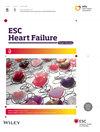Home-operated ultrasound exam for detection of worsening heart failure (HOUSE-HF)
Abstract
Aims
Acute decompensated heart failure (ADHF) is associated with a high degree of morbidity and mortality. Dynamic lung ultrasound artefact called B-lines can be obtained at the bedside and directly correlate with pulmonary vascular congestion. Obtaining patient-performed lung ultrasound images in the outpatient setting is novel. We assessed the feasibility of patients recently hospitalized for ADHF to self-perform a limited lung ultrasound using a handheld ultrasound probe and upload the images to a secure cloud for physician interpretation.
Methods
This was a prospective observational convenience sample. Patients were enrolled from an urban academic tertiary care centre and were eligible if they had chronic left-sided heart failure regardless of ejection fraction. While hospitalized, patients were educated for 20 min on a six-lung-zone image protocol, how to use the cloud archival system and given a handheld ultrasound transducer and smart tablet. A brief instructional video was also available to patients on the smart tablet throughout the study (https://www.dropbox.com/scl/fi/bii7ovdcv21ps7yxyqsy1/120-21080-00-Rev-01-BNI-041-UPENN-IN-APP-TRAINING-VIDEO.mp4?rlkey=f5vu55xbnugdoz6jzyb8lv872&st=56es4qif&dl=0). Patients were asked to upload images three times weekly, for 3 weeks, for a total of nine studies. All images were reviewed and a B-line score was calculated for each lung zone, and a total B-line score for the entire exam. Additionally, patients completed a survey to assess the patient-centred experience.
Results
A total of 15 patients were enrolled, all of whom completed seven or more studies (10 patients completed all 9). Median patient age was 63 years (range: 28 –86 years), the majority were male (73%), white (60%) and average body mass index was 33 kg/m2. Of them,33.3% had an ejection fraction >50%, average hospital length of stay was 6.3 days. Of the 792 potential images, 788 were obtained (99.5%). Of these, a total of 637 scans were interpretable (80.8%). The right upper apical lung zone (zone 1R) was most often adequate for interpretation (96.2%), where left lower mid-axillary (zone 3L) was least often interpretable (69.5%). The average number of B-lines per six-image scan was three (with a range of 0–13). Patient survey data identified zone 3L as the most challenging to obtain with overall high satisfaction with the study educational materials.
Conclusions
This pilot study demonstrates that patients with hospitalized ADHF can be taught to use a handheld portable ultrasound device and obtain and upload high quality lung ultrasound images. Compliance with the study protocol and ability to obtain some images were excellent. Further studies are needed to determine if patient-performed lung ultrasound can help detect and manage acute worsening HF in this patient population.


 求助内容:
求助内容: 应助结果提醒方式:
应助结果提醒方式:


